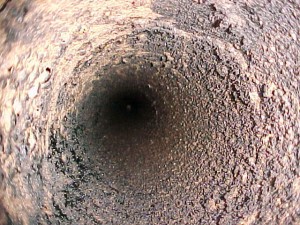What Is Creosote?
What Is Creosote? The term creosote in relation to fireplaces and chimney occurs when the by-products of wood are not totally burned off and the residue travels in the smoke as a vapor. When it is cooled to a liquid it coats whatever it encounters. The wood-tar substance is a blackish brown sticky gooey oil mixture that builds up on the interior surfaces of your chimney and fireplace. It is extremely combustible. Due to the hazardous nature of creosote and its offensive odor, Chief Chimney Services takes special care to remove it and protect homeowners from fire and toxic gas risks associated with creosote.
The Hearth.com website explains, “Creosote buildup is pretty sneaky. You may not notice it at first but it tends to feed on itself. As it builds up, it restricts the flow in the chimney and/or stove pipes. This slows the smoke on its way out, allowing more time for it to cool and for the creosote to condense and deposit on itself thus further restricting the flow.”.
The fire hazard occurs when it is ignited by a hot fire. Pieces of the built up creosote can also become loose and flake and travel upwards to your roof, or down your chimney into your fireplace and into your home. No matter the direction, the result of burning creosote is no good. A traveling piece of burning creosote can bring on a dangerous and expansive fire.
The inspectapedia website lists these considerations about creosote build up:
- The temperature of the chimney. Consider long low smoldering fires make more creosote that hotter roaring fires
- The wood to sap ratio of the wood you burn, the greener the wood the more moisture and the more creosote
- The moisture content of the wood, wet wood burns more slowly and produces more creosote
- The chimney size, height, location, and construction materials also influence the buildup of creosote.
There are important things for homeowners to understand about creosote that you need to know if you are even considering to attempt to remove creosote buildup yourself. First, without the professional equipment and cameras a chimney professional uses, you are not able to view the entire length of your chimney and therefore you may not be aware of the buildup that occurs out of sight which still puts you at risk. There are two other considerations as well as access. Dislodging the creosote is extremely dangerous for several reasons. First, as you chip away at the creosote you may do damage to the underlying chimney structure. Worse you will be breathing the extremely toxic materials even if you wear a mask. Worst yet, if you dislodge the creosote it may travel in the smoke and downdrafts of future fires and ignite whatever it lands upon.
Creosote inspection and removal is critical to the safety and security of your home and best done by a technician certified by the Chimney Safety Institute of America. CSIA certified technicians know the proper methods, cleaning agent, and tools to keep your chimney unblocked. Chief Chimney Services, Inc.wants to be your chimney professional. Contact us today!

